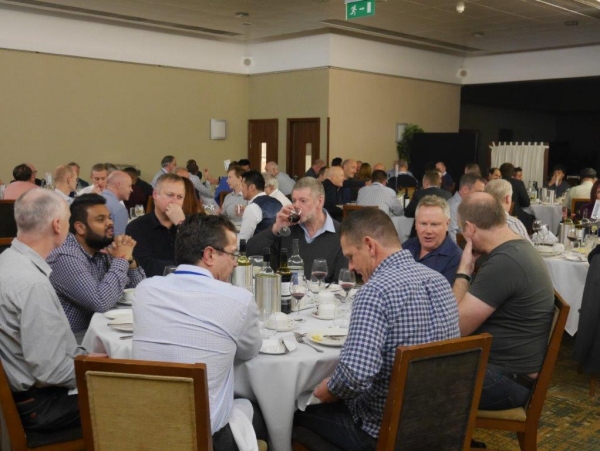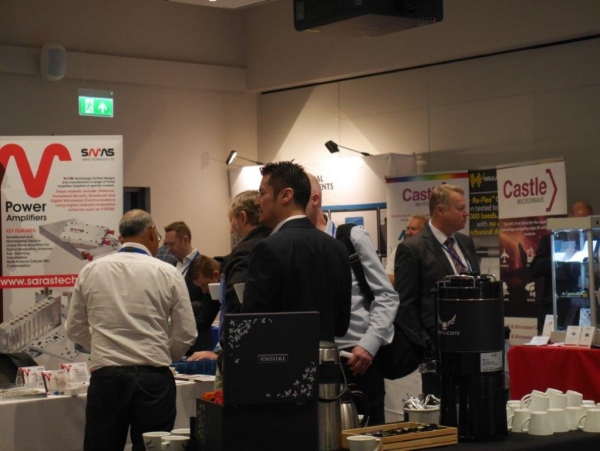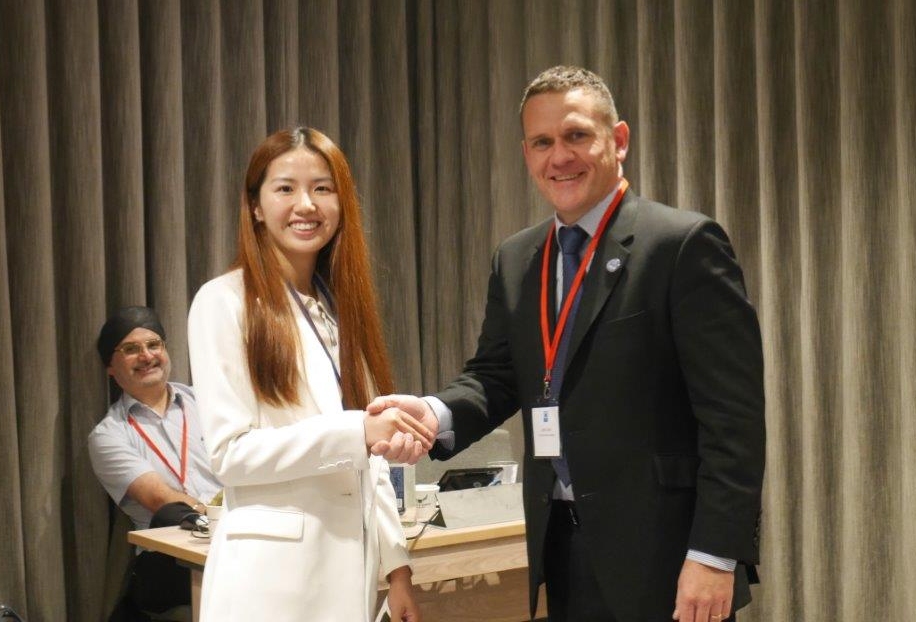Young Engineer Sponsorship: The ARMMS RF & Microwave Society provides sponsorship for young engineers (28 or below) who have had papers accepted for presentation at each meeting. Jonathan Rawlinson of Surrey Satellite Technology and Anqi Chen of Liverpool University were sponsored to attend the November 2018 meeting. Sponsorship is £100 cash plus free attendance (including conference dinner and overnight accommodation). This will be increased to £200 from April 2019. Potential candidates should identify themselves as eligible at time of submission and state their date of birth. This offer is limited to a maximum of 2 places per meeting.
Best Paper Award: The Steve Evans-Pughe prize is awarded to the best presenter at each meeting. Dominic Fitzpatrick of PoweRFul Microwave won the November 2018 award, the runner-up was Anqi Chen of Liverpool University. The award is £200 for the best paper and £50 for the runner-up. The prize is sponsored by NI.
For exhibition enquiries please email exhibition@armms.org, for all other enquiries please email enquiries@armms.org
 |  |  |
Wyboston Lakes
Great North Road
Wyboston
Bedfordshire
MK44 3AL
| sales@wybostonlakes.co.uk | |
| Web | http://www.wybostonlakes.co.uk/ |
Avtar Virdee
Microwave Technology Ltd
| Jonathan Rawlinson | |
| Surrey Satellite Technology Ltd | |
Future cognitive radio systems will be operating in very signal dense environments, with numerous generations of radio systems in operation utilising different protocols all in the same frequency bands. The aim of this project was to design and build a radio system that is capable of classifying different radio signals using convolutional neural networks and novel feature extraction methods. It was proposed that this technology can be used to build more reliable and more agile Dynamic Spectrum Access (DSA) systems. Overall, a robust classification system for signals in the shortwave radio bands has been designed and constructed using a HackRF Software Defined Radio (SDR) as the data source. | |
96 kW Industrial Hybrid Microwave Drying System Design | |
| Korkut Yegin1, Olcay Yigit1, and Murat Merdin2 | |
| 1 Ege University Electrical and Electronics Engineering, 2 MET Ltd Microwave Drying Systems | |
High power microwave drying systems offer great advantages in terms of power efficiency and processing. In the case of fresh fruits, microwave drying systems reduce the moisture content from 40-60% to 20-25%. When microwave drying process is coupled with hot-air injection into the chamber, the quality of the processed fruits is better than microwave only system. In this study, 96 kW hybrid microwave drying system operating at 2.45 GHz ISM band is designed for fig drying. To significantly lower the cost of the system, 1 kW magnetrons arranged in spatial orientation are utilized for each respective chamber of the system. Uniform heating over the running belt in this multimode applicator is targeted. The ends of the oven are open for loading and unloading of fig trays, which demands careful leakage suppressor design to satisfy 5mW/cm2 field intensity outside the chamber. Another goal of this high power design is the reduction of aflatoxins, a carcinogen produced by certain molds which exist in hot and humid areas where fruit plants are abundant. The whole system is designed, built, and validated with measurements. | |
| 96 kW Industrial Hybrid Microwave Drying System Design | |
A Dual Channel SMT Packaged PA for 26GHz 5G | |
| Stuart Glynn and Liam Devlin | |
| Plextek RFI | |
Considerable effort is currently being expended on the development of mm-wave 5G components and systems operating in the key candidate bands. In Europe the Radio Spectrum Policy Group (RSPG) has identified the 26GHz Band (24.25 to 27.5GHz) as the ‘Pioneer Band’ for mm-wave 5G. This article describes the development of a dual channel Power Amplifier (PA) housed in a custom laminate SMT package that covers the full 26GHz 5G band. The PA MMIC was designed by Plextek RFI (now PRFI); it offers a gain of 22dB with an RF output power of 26dBm at P-1dB and a PAE of 30%. The laminate packaged dual band component was developed in collaboration with Filtronic with support from the UK’s Compound Semiconductor Applications Catapult (CSA Catapult). Details of the design, implementation and measured performance of both the MMIC and the dual channel packaged component will be presented. | |
| A Dual Channel SMT Packaged PA for 26GHz 5G | |
Asymmetrical Doherty Power Amplifier for 8dB PBO and Dual Band Coverage | |
| Jack Brunning | |
| Saras Technology Ltd | |
Asymmetrical doherty power amplifier for 8dB PBO and dual band coverage. A DPA has been designed to cover 2 common cellular bands and achieve ~50% drain efficiency with >30dB uncorrected ACLR when evaluated with a 7.8dB PAPR 3.84MHz CHBW test signal whilst delivering 35W RMS output power. The design includes nested source/load pull analysis, fundamental analysis of the DPA operation including device periphery calculations, phase offset analysis and detailed design of the 4:1 and 2:1 combining network for load modulation. Also reviewed are measurement techniques for the source and load networks as well as measurement of the phase offsets and combining networks presented as modelled vs measured datasets. Final performance using modulated test signals is presented. | |
| Asymmetrical Doherty Power Amplifier for 8dB PBO and Dual Band Coverage | |
Challenges of using Solid-State Sources for Microwave Cooking and Heating Applications | |
| Kauser Chaudhry | |
| Cardiff University | |
This paper outlines the challenges of using solid-state sources for microwave cooking and heating applications by characterizing cylindrical cavity resonator impedance behaviour under variable loading conditions – represented by volumes of water ranging from 50mili-litres to 120mili-litres. Impedance variations due to changes in volume and temperature are captured to highlight hostile loading conditions at device plane, limiting the use of solid-state sources for commercial applications. A circulator and high power load can be used to protect the device against these hostilities - at the expense of additional cost and reduced available power (due to reflections) to heat the load. The importance of maintaining a satisfactory impedance match between the source and load is studied and presented. | |
| Challenges of using Solid-State Sources for Microwave Cooking and Heating Applications | |
Design of Reconfigurable Power Dividers with Wide Tuning Ranges | |
| Anqi Chen | |
| Liverpool University | |
This paper presents and investigates a novel two-way power divider design with controllable operating frequencies by adding a pair of capacitors in parallel with the transmission lines in a Wilkinson power divider. This method can either provide a tunable bandwidth by introducing an extra in-band reflection zero, or provide are configurable single operating frequency. Two circuits are fabricated to validate the method. For the bandwidth tunable power divider, the added zero- reflection frequency is sensitive to the capacitors so that the bandwidth can be tuned by altering the capacitance of the capacitors. Measured results indicate that the device has a 15-dB fractional bandwidth varying from 0 to 93%.For the center frequency tunable power divider, the single operating frequency also has high sensitivity to the capacitance. The measured tunable center frequency range is f Max: f Min = 4.67:1 | |
| Design of Reconfigurable Power Dividers with Wide Tuning Ranges | |
Development of an advanced compact GaN on SiC HEMT Model for a Packaged 250W P-band Pulsed Radar Transistor | |
| Jonathan Leckey, Andrew Patterson 1; James Custer, Gabriele Formicone, Jeff Burger, John Walker 2 | |
| 1: IconicRF 2: Integra Technologies | |
This paper will first describe the methodology used for the development of a full non-linear temperature-dependent model for a 200?m GaN on SiC HEMT unit cell. The excellent agreement between measured and modeled IV, CV and S parameters will be demonstrated. Next the paper will detail the development of a full non-linear model for a 250W 36mm gate width packaged GaN transistor for pulsed radar applications in P band (420-450MHz). This model was obtained by first scaling the gate width by a factor of three and then paralleling 60 of these unit cells. A 3D electromagnetic simulation was performed for the bond wires and ceramic package. This 3D electromagnetic model was then converted to a lumped element equivalent circuit and then the transistor model was embedded inside this equivalent circuit. It will be shown that this model provided excellent agreement between measured and modeled output power, efficiency and gain. | |
| Development of an advanced compact GaN on SiC HEMT Model for a Packaged 250W P-band Pulsed Radar Transistor | |
Development of an Envelope Tracked High Power Amplifier for COFDM | |
| Neil McEwan | |
| SARAS Technology Ltd | |
The paper describes design and evaluation of an envelope tracking drain voltage modulator for microwave amplifiers working at high peak-to-average power ratios. The modulator is based around a switched - mode buck converter combined with a fast linear amplifier, and achieves automatic diplexing between low and high frequency portions of the modulation spectrum. Driving a 1 – 1.5 GHz power amplifier with 60 W peak power capability, at 2.5 MHz modulation bandwidth using an LTE format signal a drain efficiency improvement of 10% has been obtained. A breakdown is presented of the main factors contributing to this efficiency, distinguishing between fixed and scalable processing overheads. Also discussed is the problem of optimising the delay line required in the main signal path. | |
| Development of an Envelope Tracked High Power Amplifier for COFDM | |
Parasitic Extraction and Verification of PCB layouts using EM solvers | |
| Macolm Edwards | |
| AWR Group, NI | |
Printed circuit board design of complex systems has often been conducted using a set of EDA tools that each focus on the specific technology of the various sections of the complete design. FPGA, RF and Microwave, high speed analogue etc. For the RF and Microwave engineers their design is defined by schematics populated with RF and Microwave centric models. The control of the device selection (active and passive parts) and interconnect design is managed by passing to the PCB department the requirements and constraints documentation which accompanies the circuit schematic. After the PCB engineer has integrated all the circuit functionality, the final layout needs to be checked to see if extra parasitics and unwanted coupling has pushed the design beyond its specification. This presentation will describe some of the options available to the high speed analogue/digital and RF/Microwave engineers when conducting post layout analysis. | |
Permittivity Measurement Using A Coaxial Probe | |
| Clive Alabaster | |
| White Horse Radar Ltd | |
There are many applications that require knowledge of the complex permittivity of dielectric materials in the RF & microwave industry and for materials analysis. Many methods for the measurement of permittivity are available and the most suitable method is often driven by the frequency band and the nature of the dielectric materials in question. This paper presents a coaxial probe technique that interfaces with a vector network analyser to provide a convenient wideband measurement within the microwave band. It solves a thorough and complex model for the admittance at the probe end quickly and requires only a short-circuit reference in order to achieve simplicity of operation and accurate results. Some initial results using the coaxial probe are presented which confirm its accuracy. | |
Power Handling of Strongly-Coupled Striplines | |
| Dave Andrew | |
| Vectawave Ltd | |
Strong coupling in stripline is readily achieved by the use of partial to complete broadside coupling configuration. The requirement for high even mode impedance leads to narrow lines, when compared with attached transmission lines, and hence to reduced RF current for acceptable temperature rises. The presence of the coupled line, which also carries RF power, adds extra thermal load. Thermal analysis may be performed, by way of analogy to electrical circuits, to predict maximum power handling in a given configuration. The example of a 2.45GHz equal division coupler demonstrates power limitation due to the coupler is considerably lower than the 50? lines that connect to it. It is shown too that the contribution of dielectric loss is diminished in the coupled line. | |
| Power Handling of Strongly-Coupled Striplines | |
Resolving Stability Issues in a 200W L Band CW Power Amplifier | |
| Dominic FitzPatrick | |
| PoweRFul Microwave | |
During the development of a 200W 1350-1850MHz Push-Pull solid state GaN PA, a number of issues, which at first glance looked like being related to stability, were encountered. This paper describes the investigation of these phenomena with the help of CAD modelling to determine the actual causes and to develop and implement solutions. | |
| Resolving Stability Issues in a 200W L Band CW Power Amplifier | |
Technologies 20 Years On - a look at the changes and developments in RF and microwave technologies over the last 20 years | |
| Steve Nightingale | |
| CMS Technologies | |
This presentation will look at the changes that have taken place in RF and Microwave technology over the past 20 years. It will review trends and restrictions, advances in computer hardware and the development of 2.5/3D EM simulation software and the role it plays in hardware development. Multiphysics design, MMIC technology, hybrid circuit technology, low cost electronically steered antennas and manufacturing techniques will all be discussed. | |
Testing a 26-28GHz Power Amplifier using the new 5G New Radio Test Standard, challenges and results | |
| Tudor Williams | |
| CSA Catapult | |
An ever increasing requirement for data on mobile networks, driven by a myriad of applications from HD video on the move to autonomous vehicles and Industrial IOT, means a portion of the new 5G network is to be deployed at mmWave frequencies, with a pioneer band defined for the UK between 26-28GHz. This near 10 fold increase in frequency over 4G networks opens a number of challenges, both in design and implementation of the required sub-components and network infrastructure, and in the test and measurement approaches used to drive these developments. In this presentation we will introduce some of the challenges in test and measurement of these device at these frequencies, we will then present the testing of an 26-28GHz pioneer band dual channel amplifier evaluation module using 5G NR test waveforms. | |
| Testing a 26-28GHz Power Amplifier using the new 5G New Radio Test Standard, challenges and results | |
Companies booking two or more delegate places are able to take part in the commercial exhibition that accompanies the conference. Please note: there is a maximum of 20 exhibition tables at each meeting, these are offered on a first come basis. Booking two delegate places does not guarantee an exhibition space, please email exhibition@armms.org to check availability and reserve and exhibition space.
The society would like to thank NI for sponsoring the November 2018 meeting:
Contributions are invited with an emphasis on RF and microwave design, research, testing and associated subjects. An oral presentation will be made at the meeting and a written paper will be required for publication in the society digest, which is distributed to delegates at the meeting. Prospective speakers are requested to submit a title and a short abstract to the technical coordinator (see above) as soon as possible.
Click here to view our Guidelines for Authors
Click here to view our Publication Release Form